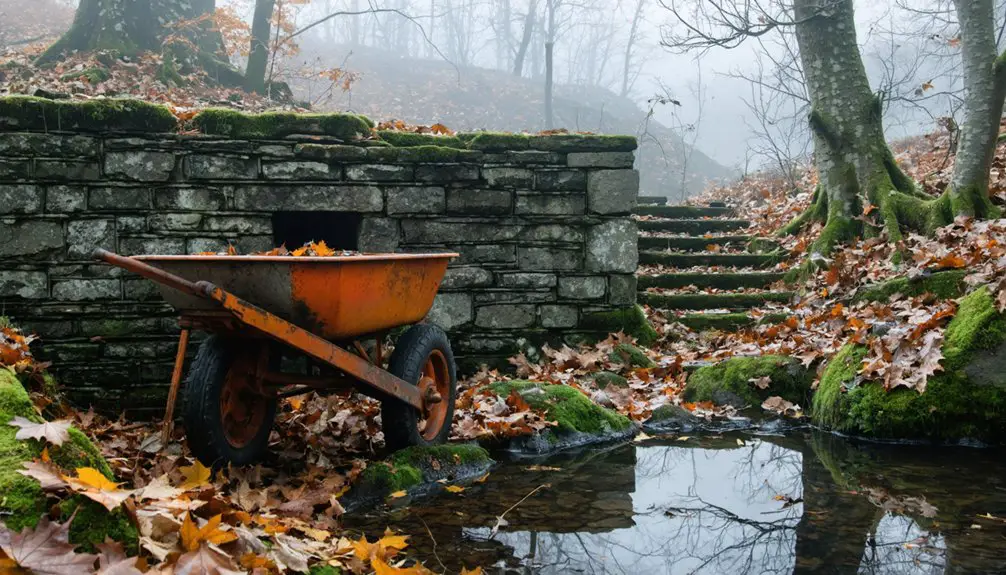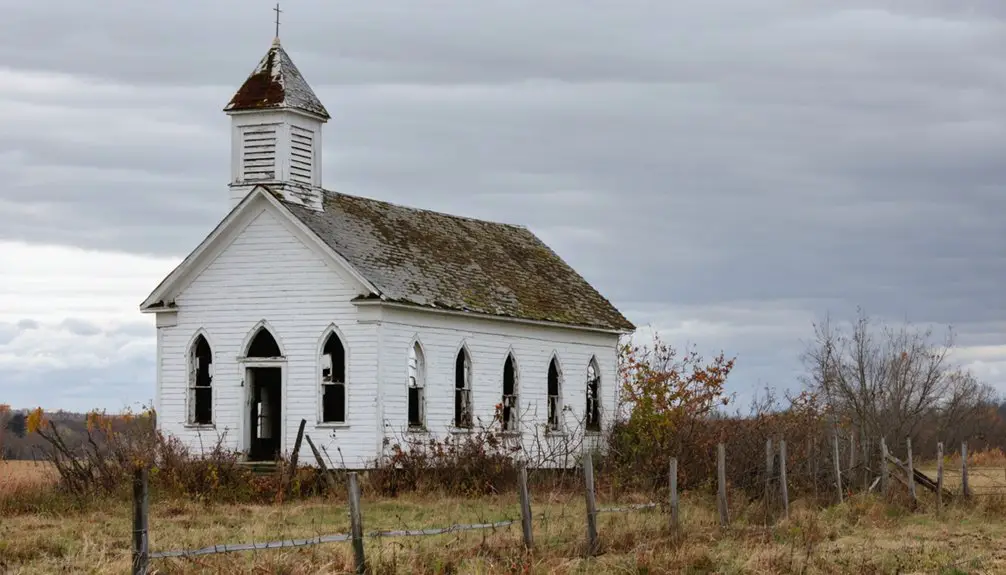You’ll discover South Poultney’s ghost town in Vermont’s Rutland County, where abandoned slate quarries and textile mill ruins mark a once-prosperous frontier settlement. First settled in 1771 by Thomas Ashley and Ebenezer Allen, this pioneer community thrived until the early 1900s when industrial competition and changing transportation routes triggered its decline. Today, crumbling industrial sites and local legends of the Eddy House haunt these quiet hills, each abandoned building holding untold stories of Vermont’s past.
Key Takeaways
- South Poultney transformed from a thriving frontier settlement to a ghost town following economic decline in early 20th-century industrial collapse.
- Multiple mill closures, failing slate industries, and abandoned copper mines contributed to South Poultney’s economic downfall and population decline.
- The arrival of major railways initially boosted trade but ultimately drew business away to larger towns, diminishing South Poultney’s importance.
- The community’s first settlers faced extreme hardships in 1771, setting a precedent for later challenges that led to abandonment.
- Local folklore and ghost stories, particularly around Ghost Hollow Road and Eddy House, preserve cultural memory of the abandoned town.
The Rise and Fall of a Pioneer Settlement
While Vermont was still contested territory in the late 18th century, South Poultney emerged as a frontier settlement on the western edge of Rutland County.
You’ll find the story of pioneer resilience in the first settlers, Thomas Ashley and Ebenezer Allen, who built log shanties along the Poultney River in 1771. Despite land disputes between New York and New Hampshire that slowed migration, hardy families from Connecticut and Massachusetts carved out a life here among the thickly wooded hills. The area was especially attractive to settlers due to its warm, productive soil along the river. The pioneers faced challenges from the untamed wilderness including encounters with abundant wolves and deer in the region.
Community bonds formed through shared hardships, as these determined settlers built rough homes with stone hearths and established burial grounds.
Early Hardships and Survival Tales
From the moment settlers arrived in South Poultney in 1771, they faced life-threatening challenges that tested their resolve daily.
You’d find these pioneers hastily constructing log homes with just axes and augurs, often moving in before proper roofing was complete. Their settler resilience showed as they crafted basic furniture from poles and slabs, relying on crude stone fireplaces for warmth. Before European settlement, this same land had been home to indigenous inhabitants for over 12,500 years.
Winter survival meant battling brutal cold with insufficient shelter while searching for food. You’d see families trekking 30 miles to Manchester just to mill their grain, though they’d later find relief when closer mills opened in Pawlet. Their isolation was heightened by the fact that Lake Champlain served as the only major transportation route between Canada and New York City.
Settlers endured harsh winters and grueling journeys to mill grain until local mills finally brought welcome relief to their struggles.
The dangers were real – just ask about Joel Grannis, who froze to death in the woods, becoming one of the first buried in local soil. Survival hinged on community cooperation and raw determination.
Native American Heritage and Archaeological Findings
Three major archaeological periods chronicle Native American life in South Poultney: the Paleoindian (10,500-7000 BC), Archaic (7000-1000 BC), and Woodland (1000 BC-1600 AD) eras.
You’ll find evidence of cultural continuity throughout these periods, particularly during the Middle Woodland era, when Native peoples thrived along the Poultney River watershed.
Native artifacts discovered in the area’s well-preserved Paxton sandy loam reveal a rich indigenous heritage. The community developed complex tribal structures through their agricultural practices.
You’ll see chipped quartzite tools, decorated pottery, and even obsidian points suggesting long-distance trade networks.
Local collections include bannerstones, bone fishhooks, and steatite vessels – all evidence of sophisticated craft production.
In the 19th century, the discovery of a wigwam burial site added to South Poultney’s documented indigenous history, though many archaeological treasures likely remain hidden beneath the soil.
Economic Evolution and Industrial Decline
You’ll find South Poultney’s economic descent began in the early 20th century as its once-bustling mill operations steadily closed down and transport routes shifted away from the area’s industrial core.
The region’s slate industry, which had peaked between 1907-1910, faced mounting competition from artificial materials and declining sales after 1910, leading to widespread quarry closures.
The collapse of these resource-based industries transformed South Poultney from a thriving industrial center into a ghost town, leaving behind abandoned quarries and industrial ruins as evidence of its former prosperity.
Mill Operations Fade Away
While South Poultney’s early industrial success relied heavily on its water-powered mills, the mid-1800s marked a turning point that would ultimately lead to their decline.
You’ll find that traditional mill technology couldn’t keep pace with emerging industrial innovations, as steam power and electricity revolutionized manufacturing processes.
The region’s mills faced several critical challenges:
- Depletion of local forest resources undermined saw mill operations
- Advanced farming equipment reduced reliance on grist mills
- Railroad expansion redirected commerce away from small mill towns
- Skilled workers shifted to more lucrative slate quarrying and mining
This decline was particularly stark given that South Poultney once boasted six saw mills along the Poultney River.
The shift was further accelerated when iron plows appeared around 1825, making traditional grain processing less essential to local farmers.
Transport Routes Shift Focus
As transportation networks evolved in the early 1800s, South Poultney’s strategic position along the Poultney Turnpike began to lose its economic importance.
You’d see the first signs of transport evolution when the Champlain Canal opened in 1823, offering a more efficient route that drew traffic away from the toll road’s stagecoaches and wagons.
The region’s economic transformation accelerated as railroads emerged, connecting major cities like Boston and Rutland. Local farmers who once relied on the turnpike found new opportunities through the Rutland and Washington Railroad in 1851.
The Delaware and Hudson Company later established rail service between Eagle Bridge and Rutland, further shifting transportation patterns in the region.
While the turnpike had once bustled with local commerce and mail delivery, you’d now find its influence waning.
The 10-cent tolls and minimal profits couldn’t sustain the road’s private operation, leading to its conversion to a public highway by 1831.
South Poultney’s role as a transport hub diminished as newer infrastructure bypassed the village entirely.
Resource Industries Collapse
The prosperity of South Poultney‘s resource industries began to unravel in the early 20th century, marked by the decline of its once-thriving slate quarries.
You’d have witnessed dramatic changes as resource depletion and shifting market demands transformed the region’s economic landscape. The collapse affected multiple sectors:
- Slate production peaked around 1907-1910 before falling to artificial material competition
- Copper mining operations, once Vermont’s second-largest nationally, became ghost towns
- Textile mills shut down or were repurposed, eliminating industrial jobs
- Traditional industries gave way to agricultural focus, particularly dairy farming
Labor migration followed as skilled Welsh quarrymen and Cornish miners left the area.
While surrounding communities like Middletown Springs adapted through agricultural diversification, South Poultney couldn’t maintain its industrial workforce, leading to its eventual abandonment.
Transportation Changes and Community Impact
During the mid-19th century, South Poultney’s landscape transformed dramatically with the arrival of major rail lines, including the Rutland Railroad and Delaware & Hudson routes.
This transportation transformation disrupted traditional stagecoach and river commerce, shifting the region from isolated farming to a more connected trade hub.
You’ll find that this change initially boosted South Poultney’s prospects, as farmers and manufacturers could now ship goods to distant markets.
Similar to the phantom travelers seen at Sumner Falls, ghostly loggers and merchants are sometimes reported along the old railway paths.
However, the community’s resilience faced challenges as rail connectivity drew business toward larger towns.
While rail lines brought progress, they siphoned commerce away from South Poultney as larger urban centers gained economic dominance.
When 20th-century transportation shifted from rail to highways, South Poultney’s importance as a transit point diminished.
The once-bustling rail station lost relevance, triggering a cascade of business closures and outmigration that ultimately led to the area’s ghost town status.
Local Legends and Cultural Memory

Many ghostly tales and supernatural legends permeate South Poultney’s cultural fabric, with stories dating back to its earliest settlement days in the 1770s.
You’ll find ghostly folklore woven into the very landscape, from the haunted Eddy House to the infamous Ghost Hollow Road, where tales of tragic loss still echo. Local supernatural narratives have shaped the region’s identity, preserved through generations of oral storytelling.
- The Eddy House, now High Life Ski Club Lodge, has sparked paranormal tales since the 1870s
- Ghost Hollow Road commemorates a heartbreaking story of a man’s wife lost in childbirth
- Early settler Joel Grannis’s frozen death in 1771 remains a cautionary tale
- The Bennington Triangle’s mysterious disappearances continue to intrigue visitors and locals alike
These stories aren’t just entertainment – they’re essential threads in South Poultney’s cultural tapestry.
Frequently Asked Questions
Are There Any Remaining Structures Still Standing in South Poultney Today?
You won’t find many remaining buildings with historical significance today, though there might be undocumented ruins or foundations hidden in the area’s landscape. Conclusive records aren’t readily available.
Can Visitors Legally Explore the South Poultney Ghost Town Area?
While 80% of ghost towns are on private land, you’ll need to obtain proper permits and landowner permissions before exploring. Check Poultney’s visitor guidelines and exploration regulations at the Town Clerk’s office first.
What Happened to the Residents When South Poultney Declined?
You’ll find that during economic decline, people gradually relocated to nearby towns with better job prospects, while others migrated back to their home states or followed employment opportunities in growing industrial centers.
Are There Documented Paranormal Activities or Ghost Sightings in South Poultney?
While whispers of ghostly encounters echo through local folklore, you won’t find any officially documented spectral history in the area. Stories remain purely anecdotal, with no verified paranormal activity on record.
Where Can Historical Artifacts From South Poultney Be Viewed?
You’ll find artifacts of historical significance at the Poultney Historical Society’s Melodeon Factory and Union Academy museums, where they’re actively preserving local heritage through extensive collections of tools, photographs, and everyday items.
References
- https://archive.org/stream/historyoftownofp1875josl/historyoftownofp1875josl_djvu.txt
- https://www.poultneyhistoricalsociety.org/visitor-information/prehistoric-poultney-8500-bc-1761-ad
- https://obscurevermont.com/ghost-hollow/
- http://freepages.rootsweb.com/~gtusa/history/usa/vt.htm
- https://archive.org/stream/ahistorytownpou00rugggoog/ahistorytownpou00rugggoog_djvu.txt
- https://sites.rootsweb.com/~vermont/RutlandPoultney.html
- https://en.wikipedia.org/wiki/Poultney_(town)
- https://www.poultneyhistoricalsociety.org/b
- https://vermonthistory.org/journal/83/VHS8301MigrantCulture.pdf
- https://www.hauntedplaces.org/poultney-vt/



